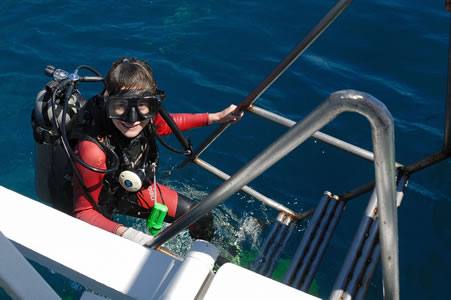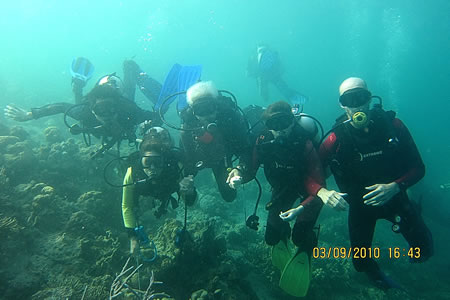English | Dutch |
|
| Ship wreck diving in Coron | |
Coron (Philippines), March 10th 2010 |
|
When we decided two years ago to get our open water diving certification, we had in mind to dive once in a while only at places that are recognised as special diving spots. And that is also how it went last years. We each have a little bit more than twenty dives and we dived so far on only four different spots here in South-east Asia (Bunaken Island and Komodo National Park in Indonesia, Sipadan in Malaysia and Balicasag Marine Reserve in de Philippines). But now, it is time for a new diving experience: wreck diving in Coron (Philippines). The little town of Coron (on Busuanga Island in the Philippines) is seen as one of the worlds best places for wreck diving. In the waters around the town, more than a dozen Japanese ships wrecks can be found, that are sunk by the Americans at the end of World War II (September 1944). The wrecks are not only former war ships, but also cargo vessels to supply the Japanese forces (more information on the wrecks: http://www.coronwrecks.com/sites.htm). It took us two full days to travel from Puerto Princesa, the capital city of the Palawan province, to this remote island in the same province. After checking in, in the Sea Dive Resort, we immediately went to the diving operator of the resort, to register ourselves for the dives of the following day. When they tell us that the Kogyu Maru and Tangat wrecks are planned, we are a little bit concerned. The wrecks are located on a depth of 36 and 30 metres respectively. We are only so-called ‘open water’ divers, which mean that we are officially allowed to go to a maximum depth of 18 metres only. When the guy in the dive shop also enthusiastically tells us that it is possible to penetrate the wrecks, we are even more concerned. “Can we also go to that depth to penetrate the wrecks with only an open water certification?”, is what we ask a little bit surprised. “Of course”, is his answer self-assured. We look at each and know immediately that we are not sure yet if we want to enter a complex wreck at a depth of more than 30 metres, only with a simple torch, while the visibility in the small corridors is only limited to a couple of metres. We are mainly looking for a diving experience to see such a monster lying on the bottom of the sea and to explore the exterior of it. |
|
 |
|
Ivonne just after diving to the Tangat wreck |
|
It is nine o’clock on the following morning when we are ready to begin with this very exciting diving day. We are classified in a group together with Maria and Juan from the USA, and Lun from China. Maria and Juan are very experienced divers, and Lun finished his open water certification only a couple of weeks ago. Our group turns out to be a very nice group. Not only the divers get on with each other, but also the dive masters Toto and Nunyo are great. During the briefing for the first dive to the Kogyu Maru, Toto convinces us to also penetrate the wreck. The holes and corridors in the ship are spacious enough to swim through them comfortably, is what he assures us. Besides that, there are enough holes in the ship for the sunlight to get in, which means that the inside of the wreck isn’t pitch-dark. However, the visibility in the corridors is only limited to a couple of metres, which means that it’s quite easy to lose each other. For that reason we make the important agreement that we swim through the ship behind each other and that we never lose sight of the fins of the diver who swims in front of you. And because we have two dive masters in our group, we can put one guide in front of the group and the other one at the rear end. We feel comfortable enough to undertake this adventure. If you stay relaxed and do not panic in case of a calamity, there isn’t a lot that can happen. However, the big question is if we can do that in case of trouble. When we approach the dive site, we start preparing ourselves for the dive. The equipment is checked again, and one more time we discuss the protocol for penetrating the wreck. After we jumped in the water and clamed down, we start the descend to the wreck. Because of the limited visibility of only ten metres, we use a mooring line. Soon after, the huge and impressive wreck appears below us. When we reach the port-side of the ship at 22 metres (the ship lies on its starboard), we let go the mooring line and descend further along the deck side of the wreck till a depth of 32 metres. We enter the ship at three different places and during the third penetration we swim through a significant part of the ship. Small corridors are alternated by huge cargo holds which makes you realise how big the ship is. This diving experience is beyond words. The last part of the dive is spent on the port-side of the wreck where we see spectacular scorpion fish, lion fish and colourful nudibranches. |
|
 |
|
Our diving group (from left to right: Lun, Maria, Juan, Ivonne and Edwin) |
|
| In three full diving days, we eventually make nine dives. We see and penetrate the six most important wrecks of the area, with the exception of the Irako wreck, which we only explored on the outside. To penetrate the Irako wreck, you have to make a dive of 40 metres, and is for this reason alone a dive for experienced divers only. Besides that, the wreck is still intact, which means that there aren’t a lot of holes for the sunlight to get in, making it a dark wreck. Somebody also told us, just before we entered the water to dive to the Irako, that they had some problems during the penetration of another wreck the previous day. They lost a couple of divers in the wreck. There are no ropes in the wreck that indicate the route, which means that getting lost in the wreck is a serious option. For this reason, following the penetration protocol is essential to prevent risking the life of others. However, in the particular group which had the accident, somebody neglected his obligations and lost sight on the diver in front of him. Eventually no real accident happened, but it makes you realize again, that wreck diving at significant depths isn’t without risks. This incident also strengthened our decision to explore the Irako only at the outside. We just weren’t confident enough that this wreck was the right one for us.
We experienced the diving days in Coron as an once-in-a-lifetime experience and it is really recommended for everybody who likes to do some wreck diving. However, realize that the wrecks are probably not suitable for divers who are still working on there self-confidence. If you are still cogitating too much about what can happen in case you get lost in a wreck or get a panic attack in a small corridor, it is probably better to postpone a trip to Coron. On the other hand, there are also shallow wrecks available near Coron. However, the big question is if you can resist the deeper wrecks when you come to Coron for only the shallow wrecks. | |